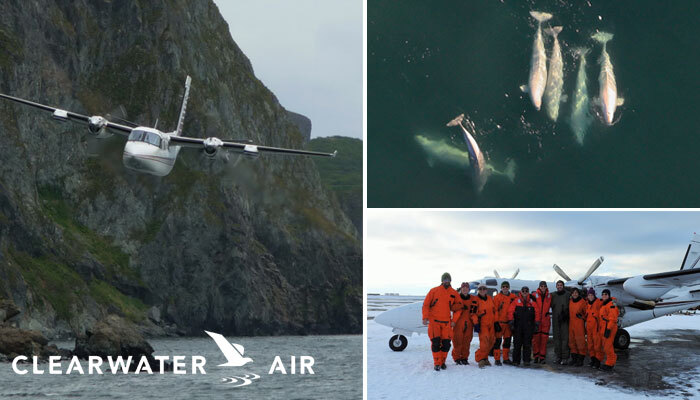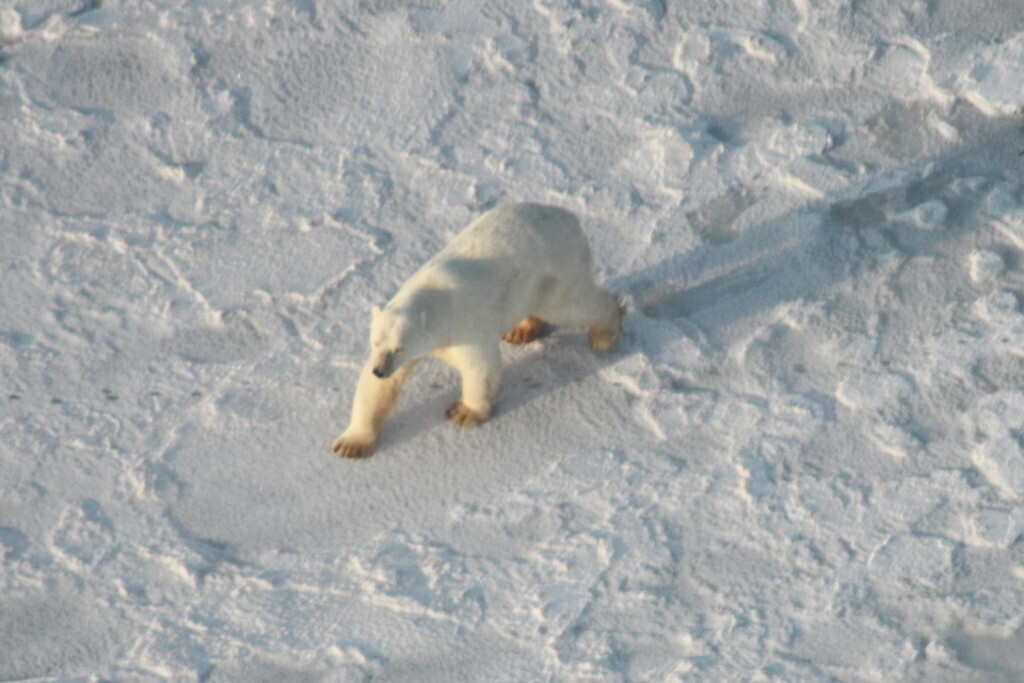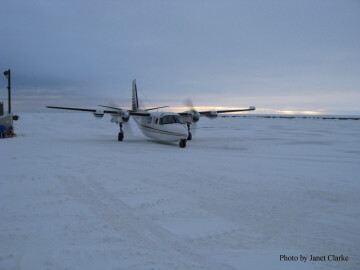
The grand spectacle of a large whale breaching the surface of the sea is the stuff of great memories and great photographs, not to mention a riveting television commercial for a certain insurance company. Andrew Harcombe can claim hundreds of such sightings—but not when leaning on the railing of a tourist-filled cruise boat. Instead, Harcombe does his whale watching from the left seat of a Twin Commander.
Harcombe owns Clearwater Air, an Anchorage, Alaska-based operator that specializes in collecting observational data on marine mammal populations in Arctic waters. “We support aerial research projects in the Arctic offshore environment,” Harcombe explains.
That explanation underplays what Harcombe and his staff of 10 pilots flying three Twin Commanders do for their daily bread. Here’s a typical example:
Several years ago Clearwater Air contracted with NOAA to fly aerial surveys in the Beaufort Sea northeast of Alaska on behalf of the Bureau of Ocean Energy Management (BOEM), an agency in the U.S. Department of the Interior charged with “managing development of the nation’s offshore resources in an environmentally and economically responsible way.” BOEM was interested in the possible effects of increased human activity in the Arctic, principally from oil and gas drilling, and an effective way to determine that was to gather data on marine mammal population trends in the region. The most efficient way to collect that data was through aerial surveys flown by Clearwater Air.
Operating out of Barrow and Prudhoe Bay along Alaska’s northern coastline, a Clearwater Air crew and three NOAA observers would depart on a mission lasting up to five hours and reaching 200 miles offshore in the western Beaufort Sea and northeastern Chukchi Sea. The Commander had been modified by replacing the standard windows in the cabin door and emergency exit with special bubble observation windows, and installing camera ports in the belly. With no cabin pressurization available, the crew flew the en route segments to far offshore research areas at 10,000 feet and a reduced, fuel-saving power setting that yielded a cruise speed of 180-200 knots.
Once on scene the crew descended to anywhere between 2,500 to 500 feet MSL, and flew pre-programmed GPS transect lines at 115 knots IAS. When a group of marine mammals was spotted, the crew flew circles to allow the observers to get an accurate count.
The Commanders are stocked with disposable urine containers, but Harcombe notes that “most of our guys and the observers have been doing this a long time, and they are physiologically capable of doing extended flights.” However, “coffee is not practical until halfway through the flight,” he adds.

Some 26 sorties were conducted in July and August, covering more than 17,000 miles including about 9,000 transect-line miles flown at low altitudes. According to the official report on the survey, observers saw 118 bowhead whales including 11 calves; 2,253 beluga whales; 60 gray whales including four calves; 13 killer whales; 923 walruses; and 28 polar bears including four cubs or yearlings. The report did not refer to the great memories recorded, but how could anyone, professional pilots and working scientists included, not be moved after seeing thousands of wild marine animals in such pristine settings.
Those kind of experiences never grow old for Harcombe. A native of Roseburg, Oregon, Harcombe began flying professionally in 1999. Over the next decade he flew everything from Cessna Caravans for a small scheduled carrier along Alaska’s north coast to the Lockheed P2V Neptune for forest fire suppression in California, New Mexico, and Florida. He also did a stint with a small operator in Alaska that conducted aerial surveys, and realized that flying for a larger purpose—one having to do with environmental stewardship—was his passion. “I am very interested in the science, in mission-oriented operations,” he explains.
That realization resulted in him buying the small aerial survey operator. “I saw an opportunity that was very closely aligned with my personal interests—the science,” he says.
That was in 2010. He quickly began expanding, adding aircraft and capabilities including a Part 135 operating certificate approved for day and night VFR and IFR. Today, Clearwater Air operates a 690A Commander, a 690B, and a 690C Model 840. The two 690s are equipped with slipper fuel tanks for long-endurance flights, as well as the bubble observation windows and a camera port. The low-altitude, slow-speed surveys are flown with a quarter-to-half flaps extended, not so much to lower stall speed as to lower the deck angle for better visibility for the observers, Harcombe explains.
Clearwater Air’s Commanders are flown by experienced crews. “Our average captain has 10,000 hours pilot-in-command time,” Harcombe says.

Why Twin Commanders? “The high wing for an unrestricted view from abeam forward, two turbine engines for safety, and the ability to fly at slow airspeeds,” Harcombe says. “But the thing that sets the Twin Commander apart from, say, a Twin Otter, is that even though we may be 200 miles offshore, we’re just 45 minutes out. The ability to fly at 115 knots for the surveys and 240 knots to escape imminent bad weather and get back is a wonderful tool to have.”
Reliability is another strong point for the Commanders, Harcombe says. “The dispatch rate is very good. We run a couple of unscheduled down days per hundred days of flying.” With April through October devoted to mission flying, inspections and major maintenance are done over the winter.
The Commanders typically stage out of Nome, Kotzebue, Barrow, and Prudhoe Bay to fly surveys over northern coastal Alaska and the Chukchi and Beaufort seas, which comprise the U.S. part of the Arctic Ocean.
Predominantly, the work is collecting data on abundance and/or distribution of marine mammals,” Harcombe says, although some missions can have a more specific objective. “We have done photo identification of individual bowhead whales based on scar patterns,” he adds.
Planning for a mission can begin months in advance, when Clearwater Air personnel confer with scientists to craft logistics and methodology for collecting the desired data. Typically, the mission involves the two Clearwater crewmembers, two observers provided by the contracting federal agency, and a third agency scientist who records the observers’ sightings. The pilots hand-fly the transect lines using a pair of WAAS-capable Garmin GNS 530s.
“If we observe whales exhibiting interesting behaviors, or locate infrequently occurring species, we may spend up to 20 minutes flying circles and getting photos,” Harcombe explains. If the animals are spotted at some distance from the pre-determined course, “we will break track, fly over and acquire them, determine the species, and make a count of the calves present. Then we return to the line and go back on transect.”
This past summer Clearwater had three projects running concurrently including a bowhead whale survey in the Beaufort Sea, monitoring offshore drilling in the Chukchi Sea, and a marine mammal mitigation program associated with commercial offshore drilling.
Given Clearwater’s low-and-slow overwater mission tactics and Alaska’s unpredictable weather, risk is a central concern. “Certainly we have dealt with unexpected situations, although there have not been any real mechanical issues,” Harcombe says. “Generally it’s an unforecast change in the arctic maritime weather. But we have an enormous amount of experience in the cockpit to help us navigate through such problems.”
One important tool that Clearwater has developed to assess and mitigate risk is a Safety Management System (SMS), a term the FAA describes as a “formal, top-down business approach to managing safety risk, which includes a systemic approach to managing safety, including the necessary organizational structures, accountabilities, policies and procedures.”
“We developed our SMS internally,” Harcombe says, “and have been very impressed with its results. As a small company we absolutely believe in the strength and purpose of an SMS. We have a very definite top-to-bottom commitment to our system. We believe very strongly in the benefits of it, and the enhanced safety with which we conduct our operations as a function of it. We want to emphasize our strong belief in our SMS, and our guys.”
Harcombe sounds much more like a dispassionate scientist than a stereotypical opinionated frontier Alaska pilot. When asked what changes have taken place in the Arctic environment over his decade of flying, he demurs. “There have been observable changes,” he says, “but I’m hesitant to state those without referencing data.” But he can’t completely mask his wonder at seeing “whales, walruses, polar bears, ice seals and harbor seals” on a daily basis when flying surveys. “It’s a whole different animal than your typical point-to-point mission,” he says, with no hint of irony in his voice.
